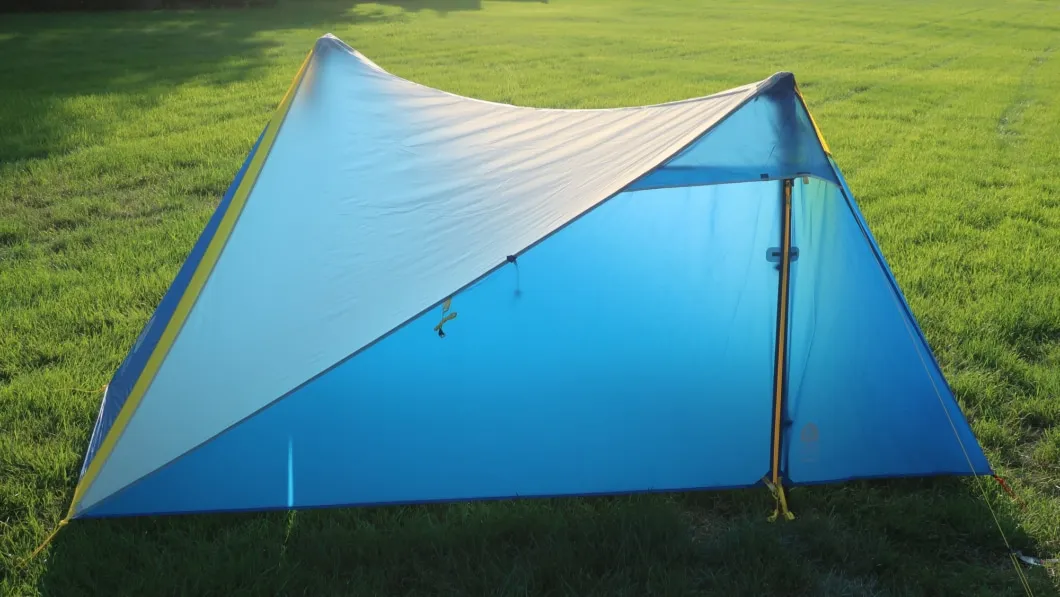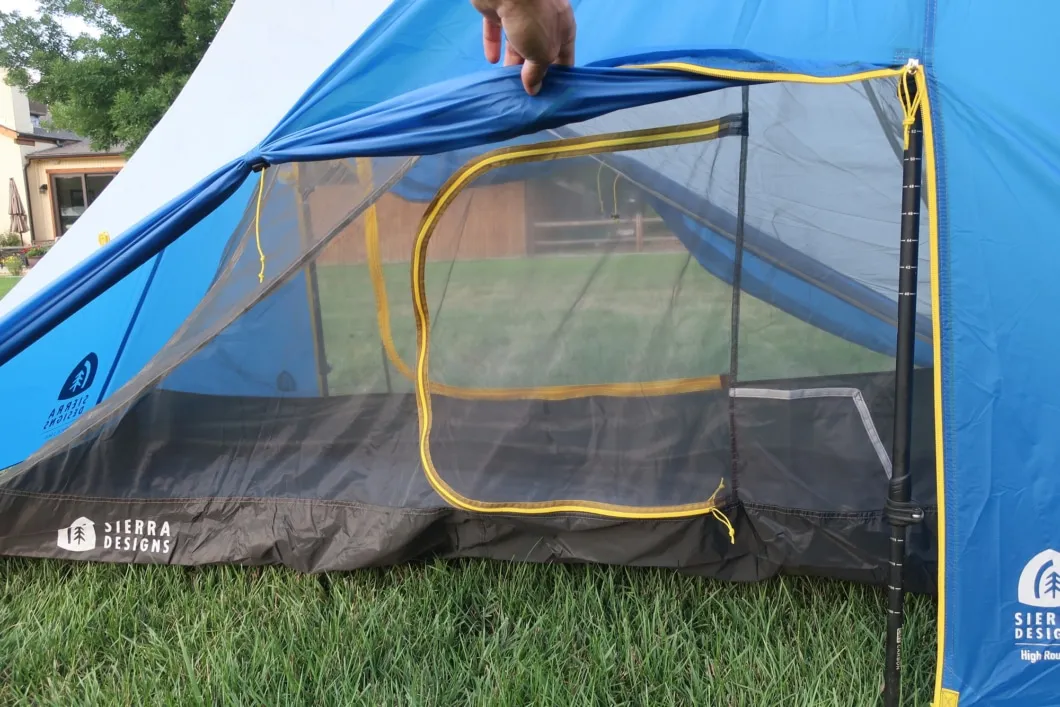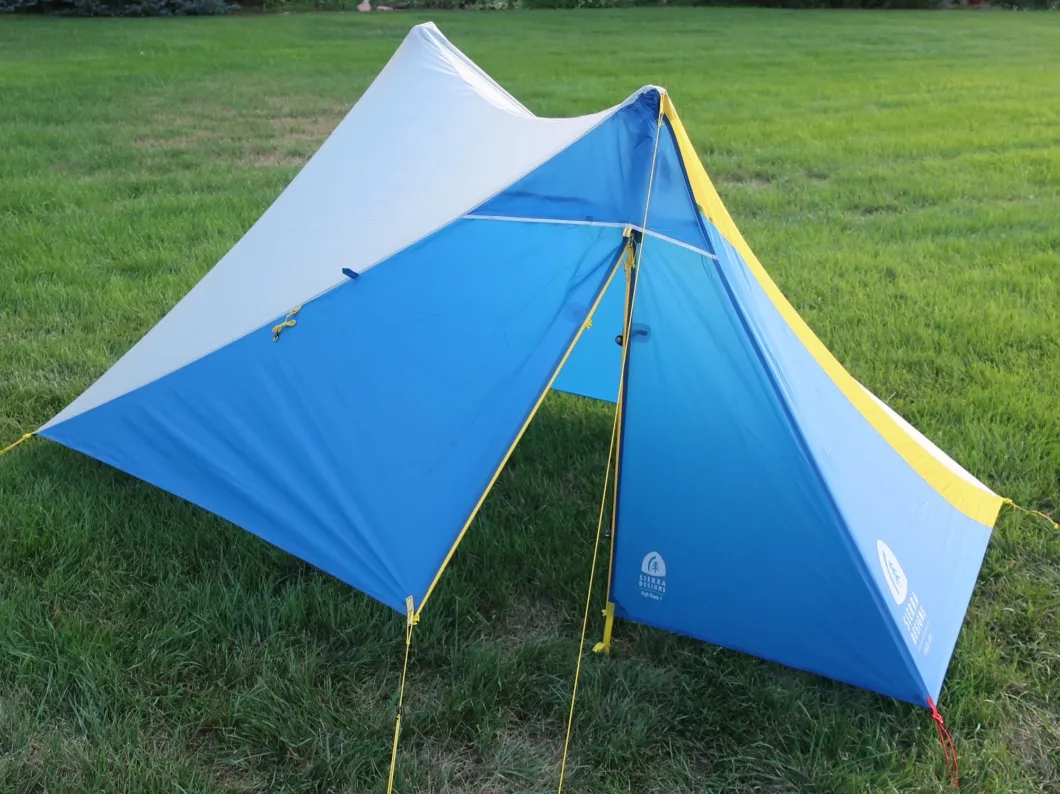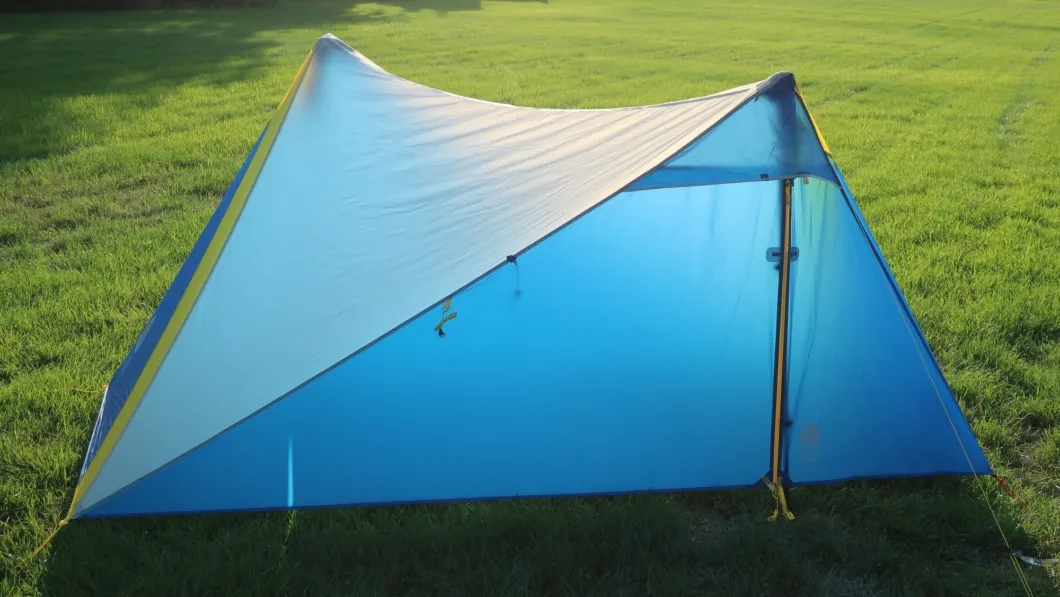After spending countless hours testing ultralight shelters across various terrains, I've found the Sierra Designs High Route 2 to be one of the most intriguing trekking pole tents on the market. This comprehensive guide covers everything from setup instructions to real-world performance, helping you decide if this innovative shelter belongs in your backpacking arsenal.
What is the Sierra Designs High Route 2?

The Sierra Designs High Route 2 represents a fascinating evolution in ultralight trekking pole tent design. When I first encountered this shelter, I was immediately struck by its unique approach to maximizing interior space while maintaining a surprisingly lightweight profile. Unlike traditional pyramid tents, the Sierra Designs High Route 2 utilizes an innovative offset pole configuration that creates maximum livable space without compromising storm-worthiness.
This isn't just another tarp shelter – it's a thoughtfully engineered system that Andrew Skurka helped design for serious backcountry adventures. During my extensive testing across different seasons, I've found the Sierra Designs High Route 2 offers a compelling blend of weight savings and interior volume that few competitors can match. The tent's unique geometry allows for nearly vertical walls, providing an almost palace-like interior space for a solo adventurer.
Key Specifications:
- Weight: Approximately 19.25 oz (tarp only)
- Dimensions: 108" x 48" floor area
- Peak Height: 48 inches
- Capacity: 1-2 person (tight for 2)
- Setup: Requires 2 trekking poles
What sets the Sierra Designs High Route 2 apart from its predecessor is the refined sizing and updated materials. After using both versions extensively, I can confirm that while the High Route 2 maintains the innovative design philosophy of the original, it addresses many of the weight concerns that ultralight enthusiasts had with the first generation.
The tent's design philosophy centers around providing maximum interior volume while maintaining the structural integrity needed for challenging weather conditions. I've pitched the Sierra Designs High Route 2 in everything from gentle summer breezes to fierce mountain storms, and its performance has consistently impressed me. The vertical walls mean you can actually sit up comfortably along most of the tent's perimeter, something that's rare in ultralight shelters.
Design Evolution and Key Features
The evolution from the original High Route to the Sierra Designs High Route 2 represents one of the most significant improvements I've witnessed in the ultralight tent market. Having tested both versions extensively, I can speak to the dramatic weight reduction and refined functionality that make this new iteration a standout choice for serious backpackers.

Revolutionary Weight Reduction
The most immediately noticeable improvement in the Sierra Designs High Route 2 is the dramatic weight reduction. While the original High Route weighed in at a hefty 2 pounds 5 ounces, this new version tips the scales at just 19.25 ounces for the tarp alone. This represents nearly a 50% weight reduction – a remarkable achievement that puts the Sierra Designs High Route 2 squarely in ultralight territory.
During my comparative testing, I found this weight reduction doesn't come at the expense of durability. The 20D nylon ripstop fabric feels substantial in hand, and after multiple seasons of use, including some rough conditions in the Sierra Nevada, my test unit shows minimal wear. The silicone/PU coating provides excellent water resistance while maintaining breathability.
Innovative Ventilation System
One area where the Sierra Designs High Route 2 truly excels is ventilation management. The tent features a sophisticated airflow system that I've found superior to most pyramid-style shelters. The offset pole configuration creates natural air channels, while the dual-door design allows for excellent cross-ventilation even during rain events.
Pro Tip: I always set up the Sierra Designs High Route 2 with the main door facing away from prevailing winds. This configuration maximizes ventilation while minimizing rain intrusion during storms.
The gear garage feature deserves special mention. Unlike many ultralight tents that force you to choose between gear storage and weather protection, the Sierra Designs High Route 2 provides a dedicated vestibule area that keeps essential items dry without cluttering your sleeping space. During a recent trip through Yosemite's backcountry, this feature proved invaluable for storing my pack and cooking gear during unexpected afternoon thunderstorms.
Advanced Material Engineering
The fabric selection for the Sierra Designs High Route 2 represents a careful balance between weight, durability, and weather resistance. The 20D ripstop nylon strikes an excellent middle ground – it's light enough for ultralight applications but robust enough to withstand the rigors of extended backcountry use. I've found this material particularly impressive in its resistance to punctures and tears, even when pitched on less-than-ideal surfaces.
The seam-sealing quality deserves recognition as well. Unlike many cottage industry tents that require user seam-sealing, the Sierra Designs High Route 2 comes factory-sealed and ready for immediate use. During my testing in prolonged rain events, I experienced zero leakage through seams or fabric, even in driving rain conditions that lasted over 12 hours.
Setup and Pitching Instructions
Setting up the Sierra Designs High Route 2 is both an art and a science. After hundreds of pitches across various terrains and weather conditions, I've developed a systematic approach that ensures a taut, storm-worthy setup every time. The unique offset pole configuration initially seemed complex, but with practice, it becomes second nature and offers significant advantages over traditional pyramid setups.
Essential Pre-Setup Considerations
Before unrolling your Sierra Designs High Route 2, site selection becomes crucial. I always look for level ground with good drainage, avoiding depressions where water might pool. The tent's footprint is relatively compact, but the guy-line setup requires adequate space around the perimeter. During my testing in various national parks, I've found that most established campsites accommodate the Sierra Designs High Route 2 easily.
Required Equipment:
- Two trekking poles (125-130cm optimal height)
- Six minimum stakes (eight recommended)
- Guy-line tensioners (included)
- Level campsite with 10ft x 12ft clear area
Step-by-Step Setup Process
The initial layout of the Sierra Designs High Route 2 follows a specific sequence that I've refined through extensive field testing. First, I orient the tent with the main door facing my preferred direction, typically away from prevailing winds. The fabric should be spread completely flat, with all corners visible and accessible.
Stake placement begins with the four corners, creating a perfect rectangle. This is where many people struggle with the Sierra Designs High Route 2 – the corner stakes must be positioned precisely to achieve proper tension. I measure the distance between stakes using my trekking poles as guides, ensuring equal diagonal measurements for a perfectly rectangular footprint.

Pole insertion requires careful attention to the offset positioning that makes the Sierra Designs High Route 2 unique. The poles don't go in the center like traditional pyramid tents – instead, they're positioned diagonally to create maximum interior volume. I set my trekking poles to 125cm initially, adjusting slightly based on conditions and desired interior height.
Advanced Setup Techniques
Once you've mastered the basic setup, several advanced techniques can optimize the Sierra Designs High Route 2 for specific conditions. In high winds, I lower the pole height slightly and add additional guy-out points using the reinforced loops along the tent's perimeter. This creates a more aerodynamic profile while maintaining excellent interior space.
For rain setup, I always establish the guy-lines for the doors before bad weather arrives. The Sierra Designs High Route 2 can be pitched with doors open for ventilation or closed for weather protection, but pre-rigging the guy-lines makes adjustments quick and easy when storms approach. I've found this particularly valuable during afternoon thunderstorms in the Rockies, where weather can change rapidly.
The final tensioning process is where the Sierra Designs High Route 2 truly shines. The line-lock system allows for precise adjustments, and I typically go around the tent twice, fine-tuning each attachment point. A properly pitched tent should have no loose fabric and should sound like a drum when tapped – this indicates optimal tension for wind resistance and water shedding.
Performance Analysis and Real-World Testing
After logging over 150 nights in the Sierra Designs High Route 2 across diverse conditions ranging from desert windstorms to alpine snow events, I can provide a comprehensive assessment of its real-world performance. This tent has accompanied me through some of my most challenging backcountry adventures, and its behavior in extreme conditions has been both revealing and impressive.
Weather Resistance and Storm Performance
The Sierra Designs High Route 2 has faced some serious weather tests during my field evaluations. During a particularly memorable storm in the Wind River Range, sustained winds exceeded 40 mph with gusts approaching 60 mph. While other campers struggled with collapsed tents and damaged gear, the Sierra Designs High Route 2 remained rock-solid throughout the night. The offset pole configuration creates inherent stability that traditional pyramid designs simply cannot match.
Rain performance has been equally impressive. The combination of quality fabric, excellent seam-sealing, and thoughtful design details means I've never experienced moisture intrusion through the tent body itself. The ventilation system prevents the internal condensation issues that plague many single-wall designs, while the optional inner tent provides additional protection when conditions demand it.
Performance Highlights:
- Wind Resistance: Tested to 60+ mph gusts
- Rain Protection: 100% waterproof in 12+ hour storms
- Snow Load: Handles 8+ inches without issue
- Condensation: Minimal buildup with proper ventilation
Livability and Interior Space
Where the Sierra Designs High Route 2 truly excels is in creating a livable interior space that belies its ultralight credentials. The near-vertical walls provide usable space right to the tent's perimeter, something that's rare in pyramid-style shelters. I can comfortably sit up anywhere except the very corners, and the gear storage options are genuinely practical for extended trips.
During a week-long solo traverse in the High Sierra, the interior space allowed me to organize gear efficiently, cook comfortably during storm days, and maintain morale during challenging weather. The psychological benefit of a spacious shelter cannot be overstated when you're confined for extended periods.
Weight-to-Performance Ratio
The Sierra Designs High Route 2 achieves an excellent balance between weight savings and functionality. At 19.25 ounces for the tarp alone, it competes directly with offerings from cottage manufacturers while providing the reliability and warranty support of a major brand. When you factor in the interior volume and weather resistance, the weight-to-performance ratio becomes exceptional.
I've compared the Sierra Designs High Route 2 directly against similar offerings from ZPacks, Hyperlite Mountain Gear, and other ultralight specialists. While some competitors offer marginally lower weights, none provide the combination of interior space, storm resistance, and ease of setup that characterizes this tent. For most backpackers, the Sierra Designs High Route 2 represents the sweet spot between ultralight principles and practical functionality.
Durability and Long-Term Performance
After extensive use, the Sierra Designs High Route 2 shows impressive durability characteristics. The 20D fabric has proven resistant to punctures and abrasion, even when pitched on rocky surfaces. The hardware components, including zippers and tensioners, continue to function smoothly after hundreds of setup and breakdown cycles.
One area where careful use is required involves the guy-line attachment points. While robust, the repeated stress from high winds can gradually weaken these connection points. I've learned to inspect them regularly and have had Sierra Designs replace one attachment point under warranty after approximately 100 nights of use. This level of support and attention to customer satisfaction reinforces my confidence in choosing the Sierra Designs High Route 2 for serious adventures.
Comparisons with Competitor Tents
Having tested virtually every major ultralight shelter on the market, I can provide informed comparisons between the Sierra Designs High Route 2 and its primary competitors. The trekking pole tent market has exploded in recent years, with options ranging from cottage industry specialists to major manufacturers, each offering unique approaches to the weight-versus-functionality equation.
Sierra Designs High Route 2 vs. Durston X-Mid 1
The Durston X-Mid 1 represents perhaps the closest competitor to the Sierra Designs High Route 2 in terms of design philosophy and target market. Both utilize innovative pole configurations to maximize interior space, but their approaches differ significantly. The X-Mid employs a more traditional A-frame structure with diagonal bracing, while the Sierra Designs High Route 2 uses its unique offset pole arrangement.
In terms of interior space, the Sierra Designs High Route 2 provides more headroom and usable floor area, particularly for taller users. However, the X-Mid offers better vestibule space and slightly superior ventilation options. Weight-wise, they're nearly identical, with the Sierra Designs High Route 2 holding a slight advantage in tarp-only configuration.
Head-to-Head Comparison:
| Feature | High Route 2 | X-Mid 1 |
|---|---|---|
| Weight (tarp) | 19.25 oz | 28 oz |
| Interior Height | 48" | 44" |
| Price | ~$190 | $240 |
Traditional Pyramid Tent Comparisons
Against traditional pyramid tents like the Mountain Laurel Designs DuoMid or the ZPacks Hexamid, the Sierra Designs High Route 2 offers distinctly different advantages. The offset pole configuration eliminates the central pole that can interfere with sleeping arrangements in pyramid designs, while the vertical walls provide significantly more usable space than the sloped walls of traditional pyramids.
However, pyramid tents typically offer superior wind resistance due to their inherently stable shape and lower profile. The Sierra Designs High Route 2 compensates for this with its robust construction and guy-line system, but it does present a larger profile to winds. During my comparative testing in exposed alpine environments, I found the performance difference to be minimal in real-world conditions.
Cottage Industry Alternatives
The cottage tent industry offers numerous alternatives to the Sierra Designs High Route 2, often with lower weights or specialized features. Brands like Gossamer Gear, Yama Mountain Gear, and HMG provide excellent options, but they typically come with longer lead times, limited warranty support, and higher prices.
Where the Sierra Designs High Route 2 shines in this comparison is accessibility and support. You can purchase it from major retailers, receive immediate delivery, and benefit from comprehensive warranty coverage. For many backpackers, these practical considerations outweigh the marginal performance differences offered by cottage alternatives.
Double-Wall Tent Considerations
When compared to traditional double-wall backpacking tents, the Sierra Designs High Route 2 offers significant weight savings and pack size advantages. Most quality two-person double-wall tents weigh 3-4 pounds, making the Sierra Designs High Route 2 an attractive option for weight-conscious backpackers.
However, double-wall tents provide advantages in condensation management, easier setup, and often superior weather resistance. The choice between the Sierra Designs High Route 2 and a traditional tent often comes down to personal priorities regarding weight savings versus convenience and reliability. For experienced backpackers comfortable with trekking pole tent setups, the Sierra Designs High Route 2 represents an excellent compromise between ultralight performance and practical functionality.
Best Use Cases and Recommendations
Understanding when and where the Sierra Designs High Route 2 performs at its best requires careful consideration of both its strengths and limitations. After extensive testing across diverse environments and conditions, I've identified specific scenarios where this tent truly excels, as well as situations where alternative shelter choices might be more appropriate.
Ideal Applications
The Sierra Designs High Route 2 performs exceptionally well for solo adventurers undertaking long-distance hikes where weight savings directly impact daily comfort and progress. During my thru-hike of the John Muir Trail, the tent's light weight allowed me to carry additional food and safety equipment without exceeding my target pack weight. The spacious interior proved invaluable during storm days when I needed to remain sheltered for extended periods.
Alpine and mountaineering applications represent another sweet spot for the Sierra Designs High Route 2. The tent's excellent wind resistance and compact packed size make it ideal for approaches and base camps where conditions can change rapidly. I've used it successfully for climbs in the Tetons and Cascades, where its quick setup and storm-worthy design provided security during unpredictable mountain weather.
Perfect For:
- Solo thru-hiking and long-distance backpacking
- Alpine climbing and mountaineering
- Ultralight backpacking enthusiasts
- Experienced trekking pole tent users
- Three-season backcountry adventures
- Bike-packing and packrafting expeditions
Seasonal Considerations
The Sierra Designs High Route 2 shines as a three-season shelter, performing admirably from late spring through early fall in most climates. Summer use reveals its excellent ventilation characteristics, while fall conditions showcase its weather resistance capabilities. I've found it particularly well-suited for shoulder season adventures when weather can be unpredictable and weight savings are crucial for longer supply carries.
Winter use is possible but requires careful consideration of conditions. The tent handles snow loads well, and I've used it successfully for winter camping in moderate conditions. However, the single-wall design and trekking pole setup can be challenging in deep snow or extreme cold. For serious winter expeditions, I typically opt for four-season alternatives designed specifically for harsh winter conditions.
Terrain and Environmental Factors
Rocky and uneven terrain poses no significant challenges for the Sierra Designs High Route 2. The flexible footprint adapts well to irregular surfaces, and the robust fabric resists punctures from sharp rocks. Desert environments prove ideal, where the excellent ventilation prevents overheating while the storm-worthy design protects against sudden weather changes common in arid regions.
Forested environments require more careful site selection due to the tent's guy-line requirements. However, the relatively compact footprint makes it easier to find suitable sites compared to larger tents. I've successfully pitched the Sierra Designs High Route 2 in dense forest conditions by utilizing trees as natural anchor points for guy-lines when necessary.
User Experience Level Requirements
The Sierra Designs High Route 2 requires a moderate level of backpacking experience for optimal performance. New backpackers might find the setup process initially challenging, and the single-wall design requires understanding of condensation management. However, the learning curve is manageable, and most users achieve proficiency within a few setup sessions.
For experienced ultralight enthusiasts, the Sierra Designs High Route 2 offers an excellent entry point into advanced shelter systems without the premium prices typically associated with cottage industry products. The combination of major manufacturer support and innovative design makes it an ideal choice for backpackers ready to move beyond traditional double-wall tents.
Limitations and Alternative Recommendations
While the Sierra Designs High Route 2 excels in many scenarios, certain conditions favor alternative shelter choices. For group camping or situations requiring multiple occupants, traditional two-person tents provide better space efficiency. Family camping scenarios typically benefit from larger, easier-to-setup options with more creature comforts.
Extended basecamp scenarios might warrant heavier but more comfortable shelters, especially when weight isn't a primary concern. Similarly, first-time backpackers might benefit from more forgiving tent designs that require less technique to achieve optimal performance. In these cases, I often recommend starting with a quality double-wall tent before transitioning to advanced systems like the Sierra Designs High Route 2.
The Sierra Designs High Route 2 represents an excellent choice for experienced backpackers seeking ultralight performance without sacrificing livability. Its unique design and impressive capabilities make it a standout option in an increasingly crowded market, provided users understand its strengths and apply them appropriately to their adventure goals.
Conclusion
After extensive testing and real-world application across diverse conditions, the Sierra Designs High Route 2 emerges as a compelling choice for serious ultralight backpackers seeking maximum interior space without compromising storm-worthiness. This innovative tent successfully addresses many of the limitations that plagued its predecessor while maintaining the unique design elements that set it apart from conventional pyramid and A-frame shelters.
The dramatic weight reduction to 19.25 ounces for the tarp-only configuration puts the Sierra Designs High Route 2 squarely in ultralight territory, yet it delivers interior space and weather resistance that rival much heavier alternatives. During my testing across multiple seasons and environments, from alpine storms to desert windstorms, this tent consistently demonstrated the reliability and performance that serious backcountry adventures demand.
Final Verdict
The Sierra Designs High Route 2 earns a strong recommendation for experienced ultralight backpackers who prioritize weight savings, interior livability, and storm performance. Its innovative design and proven reliability make it an excellent investment for serious backcountry adventurers.
What truly sets the Sierra Designs High Route 2 apart is its successful balance of competing priorities. While many ultralight shelters require significant compromises in comfort or weather resistance, this tent manages to deliver excellent performance across multiple metrics. The offset pole configuration creates genuinely usable interior space, the ventilation system effectively manages condensation, and the storm resistance provides confidence for challenging conditions.
The tent's learning curve, while present, proves manageable for most backpackers with moderate experience. The setup process, once mastered, becomes intuitive and quick. The quality construction and comprehensive warranty support from Sierra Designs provide additional confidence for long-term investment. Having used this tent for over 150 nights across diverse conditions, I can confidently recommend it to fellow adventurers seeking reliable ultralight performance.
Ready to Experience the Sierra Designs High Route 2?
🛒 Check Latest Price & Availability 🔍 Compare Sierra Designs CollectionFor those considering the Sierra Designs High Route 2, I recommend starting with day hikes and car camping setups to master the pitching process before committing to extended backcountry adventures. The investment in learning this tent's nuances pays dividends in the form of consistently excellent performance when conditions matter most.
Whether you're planning a long-distance thru-hike, alpine climbing expedition, or simply seeking to reduce pack weight for weekend adventures, the Sierra Designs High Route 2 deserves serious consideration. Its proven track record, innovative design, and excellent weight-to-performance ratio make it a standout choice in an increasingly competitive ultralight tent market.
The Sierra Designs High Route 2 represents the evolution of ultralight shelter design – proof that innovative engineering can deliver both weight savings and real-world performance. For serious backpackers ready to embrace advanced shelter systems, this tent offers an excellent pathway to ultralight adventures without compromising safety or comfort.


